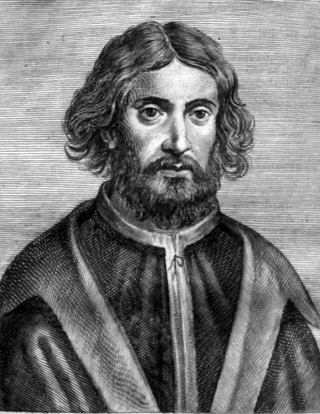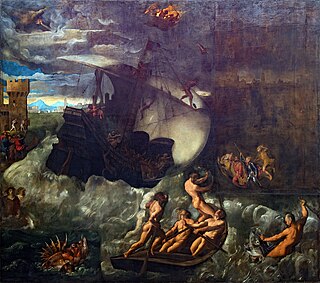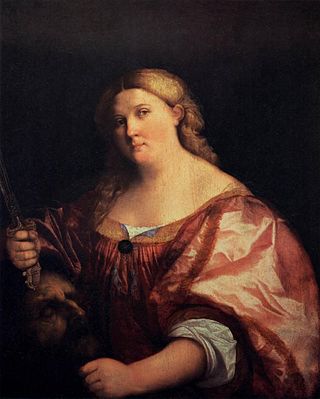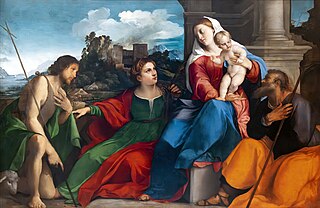
Alessandro Bonvicino, more commonly known as Moretto, or in Italian Il Moretto da Brescia, was an Italian Renaissance painter from Brescia, where he also mostly worked. His dated works span the period from 1524 to 1554, but he was already described as a master in 1516. He was mainly a painter of altarpieces that tend towards sedateness, mostly for churches in and around Brescia, but also in Bergamo, Milan, Verona, and Asola; many remain in the churches they were painted for. Most are on canvas, but a number even of large ones are on wood panel. Only a handful of drawings survive.

The Gallerie dell'Accademia is a museum gallery of pre-19th-century art in Venice, northern Italy. It is housed in the Scuola della Carità on the south bank of the Grand Canal, within the sestiere of Dorsoduro. It was originally the gallery of the Accademia di Belle Arti di Venezia, the art academy of Venice, from which it became independent in 1879, and for which the Ponte dell'Accademia and the Accademia boat landing station for the vaporetto water bus are named. The two institutions remained in the same building until 2004, when the art school moved to the Ospedale degli Incurabili.

Giovanni Battista Cima, also called Cima da Conegliano, was an Italian Renaissance painter, who mostly worked in Venice. He can be considered part of the Venetian school, though he was also influenced by Antonello da Messina, in the emphasis he gives to landscape backgrounds and the tranquil atmosphere of his works. Once formed his style did not change greatly. He mostly painted religious subjects, often on a small scale for homes rather than churches, but also a few, mostly small, mythological ones.

The Assumption of the Virgin Mary does not appear in the New Testament, but appears in apocryphal literature of the 3rd and 4th centuries, and by 1000 was widely believed in the Western Church, though not made formal Catholic dogma until 1950. It first became a popular subject in Western Christian art in the 12th century, along with other narrative scenes from the Life of the Virgin, and the Coronation of the Virgin. These "Marian" subjects were especially promoted by the Cistercian Order and Saint Bernard of Clairvaux.

The Madonna dell'Orto is a church in Venice, Italy, in the sestiere of Cannaregio. This was the home parish of Tintoretto and holds a number of his works as well as his tomb.

Palma Vecchio, born Jacopo Palma, also known as Jacopo Negretti, was a Venetian painter of the Italian High Renaissance. He is called Palma Vecchio in English and Palma il Vecchio in Italian to distinguish him from Palma il Giovane, his great-nephew, who was also a painter.

The San Giobbe Altarpiece is a c. 1487 oil painting by the Italian Renaissance master Giovanni Bellini. Inspired by a plague outbreak in 1485, this sacra conversazione painting is unique in that it was designed in situ with the surrounding architecture of the church, and was one of the largest sacra conversazione paintings at the time. Although it was originally located in the Church of San Giobbe, Venice, it is now housed in the Gallerie dell'Accademia in Venice after having been stolen by Napoleon Bonaparte.

The Girdle of Thomas, Virgin's Girdle, Holy Belt, or Sacra Cintola in modern Italian, is a Christian relic in the form of a "girdle" or knotted textile cord used as a belt, that according to a medieval legend was dropped by the Virgin Mary from the sky to Saint Thomas the Apostle at or around the time of the Assumption of Mary to Heaven. The supposed original girdle is a relic belonging to Prato Cathedral in Tuscany, Italy and its veneration has been regarded as especially helpful for pregnant women. The story was frequently depicted in the art of Florence and the whole of Tuscany, and the keeping and display of the relic at Prato generated commissions for several important artists of the early Italian Renaissance. The Prato relic has outlasted several rivals in Catholic hands, and is the Catholic equivalent of the various relics held by Eastern Christianity: the Cincture of the Theotokos of the Eastern Orthodox Church and the Holy Girdle of the Syriac Orthodox Church.

Andrea da Murano, also known as Andrea di Giovanni was an Italian painter, active mainly in Venice and the Venetian mainland.

Assumption of the Virgin is a fresco by Rosso Fiorentino in the Chiostro dei Voti of the Basilica della Santissima Annunziata in Florence.

The Adoration of the Magi with Saint Helena is an oil painting on canvas of c. 1525–1526 by Palma Vecchio in the Pinacoteca di Brera, Milan.

Storm at Sea or Saints Mark, George and Nicholas Freeing Venice from Demons is a c. 1528 oil on canvas painting by Palma Vecchio, now in the Gallerie dell'Accademia in Venice. It was partly completed in 1535 by Paris Bordon after Palma's death.

Judith is an oil on panel painting, attributed to Palma Vecchio, and created in 1525-1528. It is held in the Uffizi, in Florence. The attribution to Palma Vecchio was questioned in the past but is now usually accepted. Art historians Giovanni Battista Cavalcaselle and Joseph Archer Crowe have attributed it to Palma Vecchio, also identifying damage from heavy-handed cleaning, especially on the head of Holofernes. This attribution has been confirmed by György Gombosi and Giovanni Mariacher, who identified it as a mature work of that artist.

Madonna and Child with Saints is a c. 1520-1522 oil on panel painting by Palma Vecchio, now in the Palazzo Rosso in Genoa.
The San Giacomo Altarpiece is a 1515 oil on panel painting by Palma Vecchio which hangs in the church of San Giacomo Maggiore in the Peghera district of Taleggio, Lombardy. It is also known as Pietà with Saint James, Saint Sebastian and Saint Roch.

Holy Family with the Infant Saint John the Baptist and Saint Mary Magdalene is a 1508-1512 oil on panel painting by Palma Vecchio. It was in archduke Leopold William of Austria's collection in Brussels from 1653 to 1662 before being moved to the Imperial Galleries in Vienna, before finally being exchanged for another work with the Uffizi in Florence in 1793, where it is now inventory number 950.

Holy Family with Saint John the Baptist and Saint Catherine is a c. 1520-1528 oil on canvas painting by Palma Vecchio, now in the Gallerie dell'Accademia in Venice. It was completed by Titian after Palma's death.


















